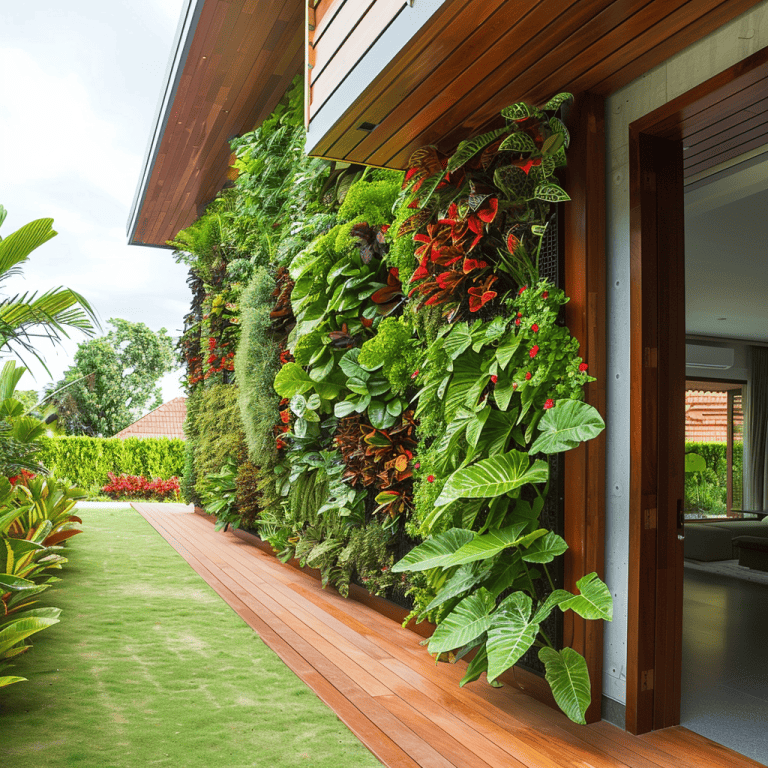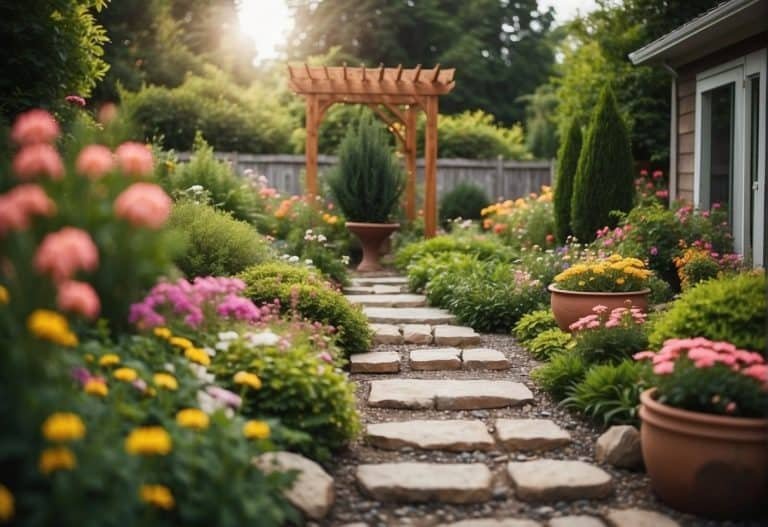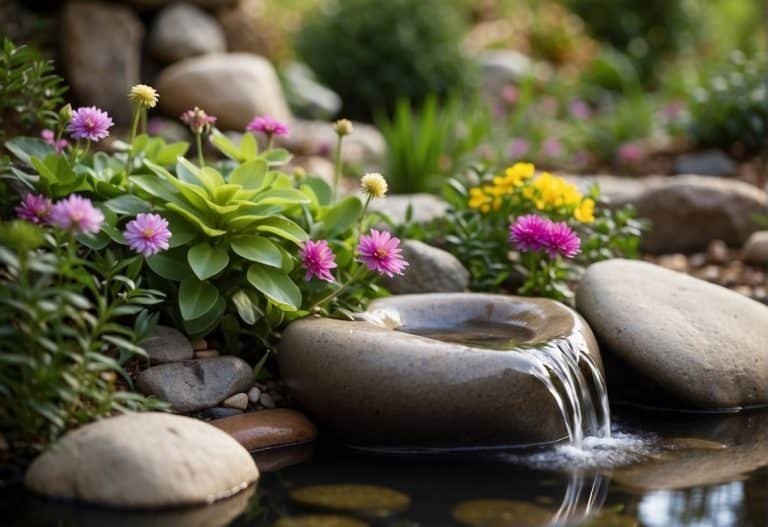11 Planter Ideas: Perfect for patio, garden, and backyard
Creating a vibrant and inviting backyard space starts with choosing the right planter ideas to complement your outdoor oasis.
When selecting planters, consider the plants you wish to grow and the style, functionality, and atmosphere you aim to craft in your backyard.
The right combination of planters can enhance your garden’s aesthetic and make your green space more enjoyable.

Planters come in an array of materials such as wood, ceramic, metal, and recycled objects, offering diverse textures and colors to fit any design vision.
Whether you’re looking for a rustic touch with wooden barrels, a modern edge with sleek ceramic vessels, or an eco-friendly vibe using upcycled items, there’s a plethora of options to express your creativity.
Matching your planters with the right plants is crucial for your plants’ health and the cohesive look of your backyard.
Space consideration is key when making your planter choices.
Large backyards can accommodate sizeable raised beds or elegant urns, while smaller patios may benefit from hanging baskets or wall-mounted planters, which add greenery without taking up valuable ground space.
Whatever your space limitations, there’s a solution that will fit your needs and transform your backyard into a lush, peaceful retreat.
Table of Contents
Designing Your Backyard Landscape

When planning your backyard landscape, consider the size of the space and the sunlight patterns to help you choose the plants.
We’ve lost plants in our recent backyard because we thought we had enough sun. But our neighbor’s growing trees and our north facing house made it hard for sun loving plants to thrive
Incorporating a personal theme or style ensures a cohesive and enjoyable outdoor area.
Evaluating Space and Sunlight
Before you begin, measure your backyard dimensions to know exactly how much room you have to work with. This will inform your decisions on the size and placement of planters.
Create a sketch of your yard to visualize the layout.
Note the areas that receive full sun, partial shade, and full shade, as this will affect which plants will thrive in each planter.
Use a table like the one below to organize your observations:
| Yard Area | Size (Length x Width) | Sunlight Exposure |
|---|---|---|
| Area 1 | 10’x15′ | Full sun |
| Area 2 | 5’x8′ | Partial shade |
| Area 3 | 12’x20′ | Full shade |
Choosing a Theme or Style
Selecting a theme or style for your backyard will give your space direction and character.
For instance, a modern minimalist garden might feature geometric planters with a monochrome color palette, while a cottage-style space may include more organic shapes and a variety of colors.
- For a modern look:
- Use materials like metal or concrete
- Stick to a neutral color scheme
- Choose plants with clean lines, like ornamental grasses
- For a cottage garden:
- Incorporate wood or distressed finishes
- Use a mix of vibrant colors
- Select plants that are lush and abundant, like lavender or roses
Your chosen style should reflect the aesthetics you enjoy and complement the existing design of your home.
Types of Planters
Selecting the right type of planter for your backyard is essential for your plants’ health and your outdoor space’s aesthetics.
Raised Beds

Raised garden beds are elevated structures that allow you to control soil quality and drainage. They are an excellent choice if you’re looking to improve root health and ease back strain during gardening.
Raised beds can be made from wood, stone, and metal.
Hanging Planters

Hanging planters add a vertical element to your garden, making them ideal for small spaces.
They can be hung from eaves, trees, or even wall-mounted hooks. To complement your backyard decor, choose plastic, ceramic, or woven baskets.
Container Gardens
Container gardens are versatile and portable, offering flexibility in arrangement and design.

Pots can range from small terracotta planters to large decorative urns, allowing you to grow anything from herbs to small trees. Ensure pots have adequate drainage to prevent waterlogging.
Vertical Planters
Vertical planters utilize vertical space to grow plants, which is perfect when horizontal space is limited.

Structures like trellises, plant stands, and wall-mounted pockets are common choices. They are especially useful for climbing plants, succulents, and small flowers.
Materials for Planters
When selecting materials for your backyard planters, consider durability, maintenance, and aesthetics to ensure they meet your gardening needs.
Wood
Wood is a classic choice for planters, offering a natural look that ages beautifully.
Cedar and redwood are great options as they are naturally rot-resistant. For a sustainable choice, look for certified sustainably-harvested wood.
- Cedar: Durable and naturally insect-resistant, doesn’t require sealant.
- Redwood: Long-lasting, resists warping and decay, and costs more than cedar.

Metal
Metal planters provide a modern twist and can be incredibly durable. However, they can conduct heat, which may affect soil temperature.
- Corten Steel: Develops a rust-like appearance that protects against further corrosion.
- Galvanized Steel: Offers a silvery finish and is rust-resistant but can get hot under direct sunlight.

Concrete
Concrete offers a robust and permanent planter option.
It withstands the elements well but is heavy, making it less suitable for areas where you may want to change the layout frequently.
- Poured Concrete: Customizable into various shapes, textures, and sizes.
- Concrete Blocks: Modular and easy to stack, though less refined in appearance.

Recycled Materials
Upcycled materials are eco-friendly and can make for unique and conversation-starting planters.
Look for items that can be repurposed without risk of contamination to the soil or plants.
- Old Tires: Highly durable and can be painted for customization.
- Plastic Bottles: Lightweight and versatile, ideal for small plants and limited spaces.
Plant Selection
Selecting the right plants for your backyard will enhance its beauty and ensure a harmonious coexistence with your local climate and soil conditions.

Flowers and Ornamentals
Annuals such as petunias and marigolds offer bright, seasonal color, while perennials like daylilies and lavender provide a recurring bloom.
Choosing native species will often result in lower maintenance and better disease resistance.
Shrubs and Small Trees
For year-round structure, consider evergreens such as boxwood or dwarf conifers.
Deciduous options like Japanese maples or hydrangeas add seasonal color and can serve as focal points. Ensure your choices are suitable for your growing zone.
Herbs and Vegetables

Consider sunlight exposure and soil quality when selecting herbs like basil or vegetables such as tomatoes.
If your ground soil isn’t ideal, use raised beds or containers. Rotate crops annually to maintain soil nutrients and prevent diseases.
Climbing Plants

Vines like clematis or climbing roses will add vertical interest and can be used to cover walls or fences.
For pergolas or arbors, wisteria or grapevines offer both shade and edible or fragrant benefits. Select species that match your structure’s weight capacity.
Irrigation Techniques
Efficient irrigation methods are vital for maintaining a healthy backyard garden. Choosing the right technique saves time, conserves water, and ensures your plants receive the hydration they need.
Drip Irrigation
Drip irrigation is a precise watering method that delivers water directly to the base of your plants, minimizing evaporation and runoff. Here’s how to set it up:
- Lay out drip tubing along your garden beds.
- Insert emitters at intervals specific to your plants’ needs.
- Connect the system to a water source with a pressure regulator to maintain consistent flow.
Advantages:
- Conservation of water: targeted delivery to roots
- Customization: adaptable to various plant types and arrangements
Self-Watering Systems
Self-watering systems rely on reservoirs for plants to take in water as needed. To implement a self-watering system:
- Use containers with built-in reservoirs, or
- Convert existing planters with aftermarket inserts.
Key Components:
- Reservoir: stores water beneath the planting area
- Wicking system: draws water up to the roots
Advantages:
- Water efficiency: reduces frequency of watering
- Consistency: provides steady moisture levels
Accessorizing Your Planters
Elevate the aesthetic of your backyard with well-chosen planter accessories that improve the health of your plants and add a touch of personality.
Decorative Mulches
Using decorative mulches is a practical way to enhance the look of your planters.
Options include:
- Pebbles: They provide a sleek look and help retain soil moisture.
- Bark Chips: These create a natural, woodsy feel and improve soil health.
Choose a mulch that complements the style of your planter and home.
Garden Ornaments
Incorporate garden ornaments to introduce character and focal points within your plant collections:
- Statuettes: Small sculptures can act as charming centerpieces.
- Wind Chimes: Add an auditory element with the gentle sounds of wind chimes.
Place ornaments strategically so they complement, not overcrowd your planters.
Lighting
Effective lighting can transform your planters into nighttime highlights:
- Spotlights: Direct focus to specific plants with adjustable spotlights.
- String Lights: Drape LED string lights for a warm, inviting glow.
Consider solar-powered options for an eco-friendly and wireless solution.
Seasonal Considerations

Consider how the changing seasons affect your planters when planning your backyard garden. Proper care for hot summers and cold winters is crucial for plant vitality.
Winter Protection
In winter, your planters are at risk from freezing temperatures and frost, which can damage plants and crack containers.
- Insulate Planters: Wrap pots with burlap or bubble wrap to insulate roots.
- Elevate Pots: Use pot feet to lift planters off the cold ground.
- Choose Hardy Plants: Opt for evergreens or frost-resistant varieties.
Summer Care
Heat can stress plants during summer, and evaporation can dry soil quickly.
- Watering Schedule: Water your plants early or late in the evening to reduce evaporation.
- Mulch: Apply a layer to retain moisture.
- Shade Solutions: Use umbrellas or shade cloth during peak sun hours to prevent overheating and sunburn on your plants.
DIY Planter Projects
Upcycling old furniture can give your backyard a vintage touch.
For example, old drawers can be transformed into charming planters.
Simply sand them down, apply a coat of wood sealer, and fill with soil and plants.
The sealer is vital; it prevents wood rot and extends the life of your planter.
Another creative project is cinder block planters.
Stack cinder blocks to create a geometric design.
For added flair, paint the blocks in bold colors before planting. Here’s a simple guide:
- Clean the blocks with soapy water and let them dry.
- Apply a primer followed by exterior paint.
- Stack the blocks in your desired pattern.
- Fill the holes with potting mix and your choice of plants.
Mason jars offer a quaint aesthetic.
Secure a series of jars to a wooden board using hose clamps, and mount your new planter on a fence or wall.
Remember to add pebbles before soil for proper drainage.
Lastly, tire planters are durable and add a playful element.
Paint used tires in vibrant colors, cut them into attractive shapes, and stack them as you see fit. Tires can be filled directly with soil and plants.
| Material | Tool Needed | Extra Tip |
|---|---|---|
| Old Drawers | Sandpaper, Sealer | Ensure proper drainage. |
| Cinder Blocks | Paint, Primer | Use a level to ensure stability |
| Mason Jars | Hose Clamps | Add pebbles for drainage |
| Old Tires | Paint | Cut creatively for visual appeal |
Remember, precise plant selection enhances these DIY projects. Choose varieties that fit the theme and size of your planters.
Maintenance and Upkeep
Proper maintenance and upkeep of your planters is crucial for the health of your plants.
Regular watering, appropriate fertilization, and timely pruning ensure vigorous growth and bountiful harvests.
Watering and Feeding
Check the soil moisture daily by feeling it about an inch below the surface to prevent over or under-watering. If it’s dry, it’s time to water.
Here’s a simple schedule to follow:
- Morning: Best time to water to reduce evaporation.
- Weekly: Check nutrient levels and apply a balanced liquid fertilizer unless you’ve already mixed in a slow-release formula.
Remember, overfeeding can burn the roots, so stick to the recommended dosage on your fertilizer’s label.
Pruning and Harvesting
Pruning is necessary to promote healthy plant growth and improve air circulation.
Snip off any dead or yellowing leaves using sharp, clean shears.
As for harvesting, picking fruits and vegetables as they ripen is best to encourage further production.
| Task | Frequency |
|---|---|
| Pruning | As needed |
| Harvesting | At ripeness |
Tip: Harvest in the morning when the plant’s sugar content is the highest for the best flavor.
Pest and Disease Management

When managing your backyard planters, vigilance is key to preventing pests and diseases from damaging your plants.
Early detection and proper identification of issues are essential for effective management.
Here are actionable strategies to protect your plants:
- Regular Inspection: Check your planters regularly for signs of pests or disease.
- Look for discolored leaves, stunted growth, or unusual spots on the plants.
- Cleanliness: Ensure that your planters and tools are clean to prevent the spread of disease.
- Remove any fallen debris and disinfect tools regularly.
- Proper Watering: Overwatering can lead to fungal diseases, while under-watering stresses plants, making them more susceptible to pests.
- Water your plants appropriately based on their specific needs.
- Healthy Soil: Use high-quality, well-draining soil.
- Consider adding compost to provide nutrients and improve soil structure, which can help plants resist pests and diseases.
Natural Remedies and Chemical Controls
- Biological Controls: Introduce beneficial insects like ladybugs or lacewings that prey on common garden pests.
- Cultural Controls: Rotate plants yearly to reduce disease carryover and prevent pest build-up.
- Chemical Controls: If necessary, use targeted pesticides or fungicides.
- Opt for organic options when possible to reduce environmental impact.






